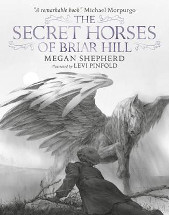The secret horses of Briar Hill by Megan Shepherd

Ill. by Levi Pinfold. Walker Books, 2016. ISBN 9781406367584
(Age: 10+) Highly recommended. Fantasy. World War Two. Britain.
Horses. When other children in London are evacuated to the country,
Emmaline is taken to Briar Hill, Shropshire, a place for children
with breathing difficulties, their 'stillwaters'. Her friend Anna,
is sixteen and confined to bed, while some children are allowed to
walk around the halls of the once beautiful building, and sometimes
Emmaline is allowed outside. Here she finds a garden, and in that
garden, a winged horse. She has already seen these animals in the
mirrors in the house, but now one is in the garden with a damaged
wing. Emmaline finds a letter left for her from the Horse Lord,
asking for her help with the wounded animal, Foxfire, but to be wary
of the Black Horse, whose shadow Emmaline has sometimes seen nearby.
A beautiful and touching story, the group of children cared for in
this building are all in various stages of illness, and their lung
problems come to the fore as the story unfolds. Emmaline is a
wonderful character, wanting to be an explorer, knowing her
tuberculosis means this is a pipe dream but heartened when Anna
tells her that she already is an explorer, seeking out the garden
and its secret, keeping the horse safe. The gardener Thomas has also
seen the horse and helps Emmaline with her quest, particularly when
the Horse Lord tells her that Foxfire is in danger with the coming
of the new moon. She is told to collect colours of the rainbow to
protect Foxfire, but finding colour in this grey wintry environment
needs all of her skills.
A moving fantasy story of a lonely child, traumatised by what has
happened to her family in Nottingham, the resolution of the story
will bring tears to the readers' eyes as she learns to accept what
has happened and comes to see there is more to life than her bleak
surroundings.
War and privation is ever present, with the house cut off from the
village and therefore the pharmacy and doctor by the weather, the
children aware of the bombing raids on the cities, their talk filled
with stories of what has happened and sometimes hearing of death.
The illustrations add a mesmerising dimension to the story and offer
the reader a visual accompaniment as they read. Several stand out
for me: the children sitting in the cellar with their gas masks on,
listening to an unsettling story told by the bully, Benny, (pages
39-40) along with Emmaline sleeping with the sheep (pages 146-7) and
Emmaline sitting on Anna's bed (pages 182-3). I kept coming back to
these as I read. But all the illustrations are deeply moving with
their greys reflecting the children's lives. With links to The
secret garden and the Narnia stories, this wonderful
story will be eagerly sought after by middle to upper primary
readers.
Fran Knight